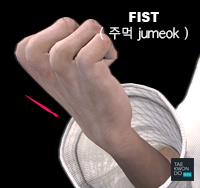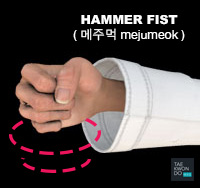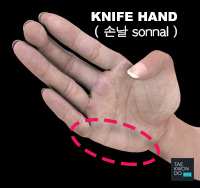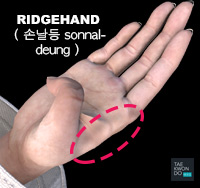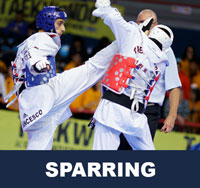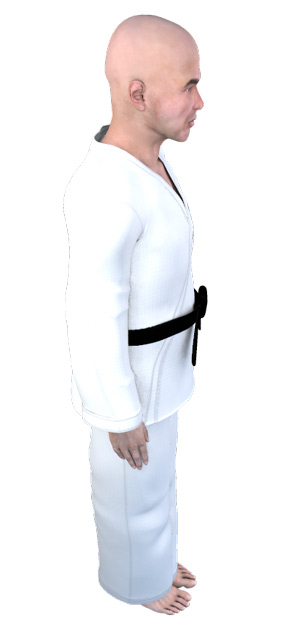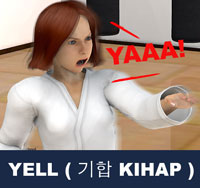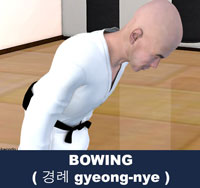Taekwondo 태권도Taekwondo Preschool
Promotion from one geup to the next can proceed rapidly in some schools, since schools often allow geup promotions every two, three, or four months. Students of geup rank learn the most basic techniques first, and then move on to more advanced techniques as they approach first dan. Many of the older and more traditional schools often take longer to allow students to test for higher ranks than newer, more contemporary schools, as they may not have the required testing intervals. View Taekwondo belt levels »

Promotion Tests | Red Stripe Belt
Red Stripe Belt Level Information
Style: World Taekwondo (WT) 
Ranking: 3rd geup
Difficulty Level: Advanced
To advance from one rank to the next, students typically complete promotion tests in which they demonstrate their proficiency in the various aspects of the art before their teacher or a panel of judges. Promotion tests vary from school to school, but may include such elements as the execution of patterns, which combine various techniques in specific sequences; the breaking of boards to demonstrate the ability to use techniques with both power and control; sparring and self-defense to demonstrate the practical application and control of techniques; physical fitness usually with push-ups and sit-ups; and answering questions on terminology, concepts, and history to demonstrate knowledge and understanding of the art. For higher dan tests, students are sometimes required to take a written test or submit a research paper in addition to taking the practical test.
Promotion from one geup to the next can proceed rapidly in some schools, since schools often allow geup promotions every two, three, or four months. Students of geup rank learn the most basic techniques first, and then move on to more advanced techniques as they approach first dan. Many of the older and more traditional schools often take longer to allow students to test for higher ranks than newer, more contemporary schools, as they may not have the required testing intervals. More information View Belt Level Ranking »
Difficulty of Promotion Test
Taekwondo students of geup ranking learn the most basic techniques first, and then move on to more advanced and difficult techniques as they approach 1st Dan Black Belt. The more difficult the techniques, the more practice may be needed for the purpose of improving or mastering it, as in the phrase 'practice makes perfect'. Every technique must display the requisite speed, balance, power and firmness to be realistically used as an attack or defense move.

Training Safety Precautions
Starting with coloured belts taekwondo students must learn Breaking ( 격파 gyeokpa ). As they progress through the ranks, the breaks they perform increase in difficulty as do the number of boards. Wooden boards are the most common breaking item in most martial arts.
There are safety concerns with taekwondo breaking ( 격파 gyeokpa ), so one should seek out a certified Master Instructor ( 사범님 sabeomnim ). There are many small bones of the foot ( 발 bal ) and hand ( 손 son ) which need to be very carefully and slowly conditioned for safety. Repeated damage to the extensor capsules of the knuckles can lead to long term problems with dexterity. View Breaking ( 격파 gyeokpa ) »
* Please see a certified Master Instructor ( 사범님 sabeomnim ) for training. Proper guidance and instructions are needed to ensure safe training.
Taekwondo Promotion Tests | Red Stripe Belt

Red Stripe Belt Level Requirements
Style: World Taekwondo (WT) 
( Techniques vary between schools )
Blocks ( 막기 makgi )
- Palm Heel Inward Block ( 바탕손 안막기 batangson-an-makgi )
- Palm Heel Assisted Block ( 바탕손 거들어 몸통막기 batangson-kodureo-momtong-makgi )
- Trunk Push Double Block ( 헤쳐막기 hecho-makgi )
- Outside Wrist Double Block ( 바깥팔목 헤쳐막기 bakkat-palmok-hecho-makgi )
- Inside Wrist Double Block ( 안팔목 헤쳐막기 anpalmok-hecho-makgi )
- Scissor Block ( 가위막기 kawi-makgi )
- Side Block ( 옆막기 yeop-makgi )
- Inside Wrist Side Block ( 안팔목 옆막기 anpalmok-yeop-makgi )
- Outside Wrist Side Block ( 바깥팔목 옆막기 bakkat-palmok-yeop-makgi )
- Supported Hand Blade Downward Block ( 손날 거들어 내려막기 sonnal-kodureo-naeryeo-makgi )
- Hand Blade Twisting Outward Block ( 손날 비틀어 바깥막기 sonnal-bitureo-bakkat-makgi )
- Inward Knifehand Block ( 손날 안막기 sonnal-anmakgi )
- Hand Blade Side Block ( 손날 옆막기 sonnal-yeop-makgi )
- Low Cross Block ( 아래 엇걸어막기 arae-otgoreo-makgi )
Stance ( 서기 sogi )
- Cat / Tiger Stance ( 범서기 beom-sogi )
- Covered Fist Ready Stance ( 보주먹준비 bojumeok-junbi )
- Forward Cross Stance ( 앞 꼬아서기 ap-koa-sogi )
Fist Strikes ( 지르기 jireugi )
- Side Punch ( 옆지르기 yeop-jireugi )
- Turn Over Punch ( 젖혀지르기 jeocheo-jireugi )
- (Fist) Turn-over Punch ( (주먹) 젖혀지르기 (jumeok) jeocheo-jireugi )
- (Double-Fist) Turn-over Punch ( (두주먹) 젖혀지르기 (dujumeok) jeocheo-jireugi )
Strikes ( 치기 chigi )
- Elbow Rear Strike ( 팔굽 뒤치기 palgup-dwi-chigi )
- Elbow Downward Strike ( 팔굽 내려치기 palgup-naeryeo-chigi )
- Outward Back Fist ( 등주먹 바깥치기 deung-jumeok-bakkat-chigi )
- Hand Blade Outward Strike ( 손날 바깥치기 sonnal-olgul-bakkat-chigi )
- Hand Blade Side Strike ( 손날 옆치기 sonnal-yeop-chigi )
- Downward Chop ( 내려찍기 naeryeo-chigi )
- Inward Chop ( 안찍기 an-chigi )
- Forward Chop ( 앞찍기 ap-chigi )
Kicking ( 차기 chagi )
- Spin Hook Kick ( 뒤후려차기 dwi-huryeo-chagi )
- Jumping Back (Thrust) Kick ( 뛰어 뒤차기 ttwieo-dwi-chagi )
- Knee Upward Strike ( 무릎 올려치기 mureup-ollyeo-chigi )
- Target Kick ( 표적차기 pyojeok-chagi )
- Front Foot Whip Kick ( 앞발 후려차기 apbal-huryeo-chagi )
- Alternating Kick ( 이어차기 ieo-chagi )
Poomse 품새
Poomse is the foundation for the teaching of Taekwondo. A poomse, or form, is a detailed pattern of defense-and-attack motions and techniques used in traditional martial arts. Poomse is useful in developing proper kinetics, mental and physical fortitude.
Most Kukkiwon schools will use the poomse taegeuk whereas a few schools will use the poomse palgwe. The meanings, trigrams and symbols are shared by both poomse taegeuk and poomse palgwe, however the sequence of movements is different. The first 8 forms of the set of poomse differ from each other, whereas the last 9 forms (Black Belt forms) of the set are shared between the two sets. All students studying in World Taekwondo (WT) Kukkiwon style must learn these forms, or taegeuk, to advance to a higher belt level. There are eight taegeuk forms, each one similar to the previous one, but each time with more complicated techniques to display the students' mastery of the techniques learned during lessons, as well as the ability to interconnect these techniques. For more information View Taekwondo Poomse 품새 »

Taekwondo Promotion Test
Testing or evaluation is important to taekwondo practitioners who wish to determine their progression or own level of skill in specific contexts. Students within individual belt levels often undergo periodic testing and grading by their own teacher in order to advance to a higher level of recognized achievement, such as a different belt color. View Taekwondo Promotion Tests »
* Please see a certified Master Instructor ( 사범님 sabeomnim ) for training. Proper guidance and instructions are needed to ensure safe training.
There are five tenets defined in the International Taekwondo Federation (ITF) and several more in World Taekwondo (WT).
Integrity ( 염치 yeom-chi ): "Although it may be similar, this form of integrity takes on a more wider role then defined in the common dictionary. In taekwondo, integrity means not only to determine what is right or wrong but also having the conscience to feel guilt if one has done wrong and to have the integrity stand up for what is right." View Taekwondo Tenets »
RESOURCES
This article uses material from the Wikipedia articles "Taekwondo", "Taegeuk" and "Hyeong" which is released under the Creative Commons Attribution-Share-Alike License 3.0.



